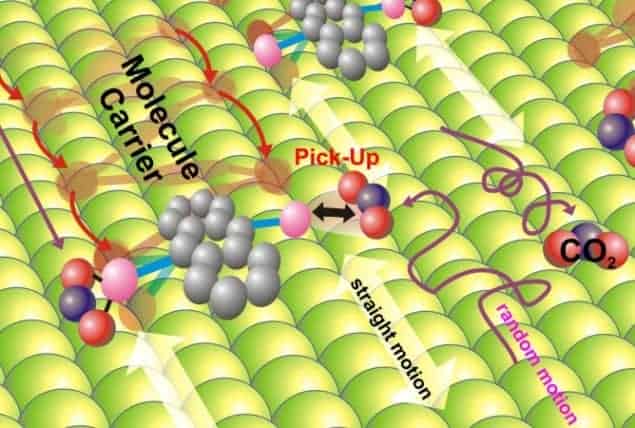A "molecule carrier" that can transport carbon dioxide molecules in straight lines across a crystalline surface has been developed by physicists in the US. The molecules hitch a ride with an organic compound called anthraquinone (AQ), which grabs hold of them and carries them over distances of about 10 nm before dropping them on request. The researchers believe that this phenomenon could be harnessed to boost the performance of surface catalysts or to improve the processing of semiconductor devices (Sciencexpress 10.1126/science.1135302).

The movement of atoms and molecules on solid surfaces plays a crucial role in many important technological processes – including surface catalysis, which removes pollutants from car exhausts, and the processing of semiconductor chips. In most cases this movement (or diffusion) occurs in random directions, with the right molecules eventually finding their way to the right – or wrong – places on the surface.
Now, Ludwig Bartels and colleagues at the University of California, Riverside along with researchers at the University of Central Florida have discovered a phenomenon that could make surface diffusion a much more regimented process. They began with a very clean copper surface that is cut to expose a flat crystalline surface. Very small quantities of AQ and carbon dioxide molecules are then deposited on the surface, such that most of the surface remains bare. AQ was used because the researchers had already discovered that it travels with great precision along straight lines defined by the crystal structure – unlike carbon dioxide and most other molecules, which move in random directions on the surface.
Bartels and colleagues observed that when a carbon dioxide molecule encounters an AQ molecule, it attaches itself and is pulled along in a straight line (see figure “Hitching a ride”). A second carbon dioxide molecule could also be picked up along the way. This journey continues until the carbon dioxide molecules were dislodged either by raising the temperature of the copper or by disturbing the carrier using the tip of scanning-tunnelling microscope (STM).
While this process was observed using a STM in an ultra-high vacuum chamber and at temperatures below 60 K, Bartels told Physics Web that it may be possible to harness the effect under less stringent conditions. The researchers are also trying to expand the carrier’s cargo capabilities by looking for molecules that are similar to AQ, but capable of carrying atoms or molecules other than carbon dioxide.
The team are currently investigating how the molecular carrier could be used to shuttle molecules to “active” sites on surface catalysts to improve their performance. Bartels also believes that the effect could someday be used by the semiconductor industry to create structures at specific locations on computer chips – something that is done today by photolithography, which involves depositing material on the entire chip and using masks and other techniques to form the required structures.



